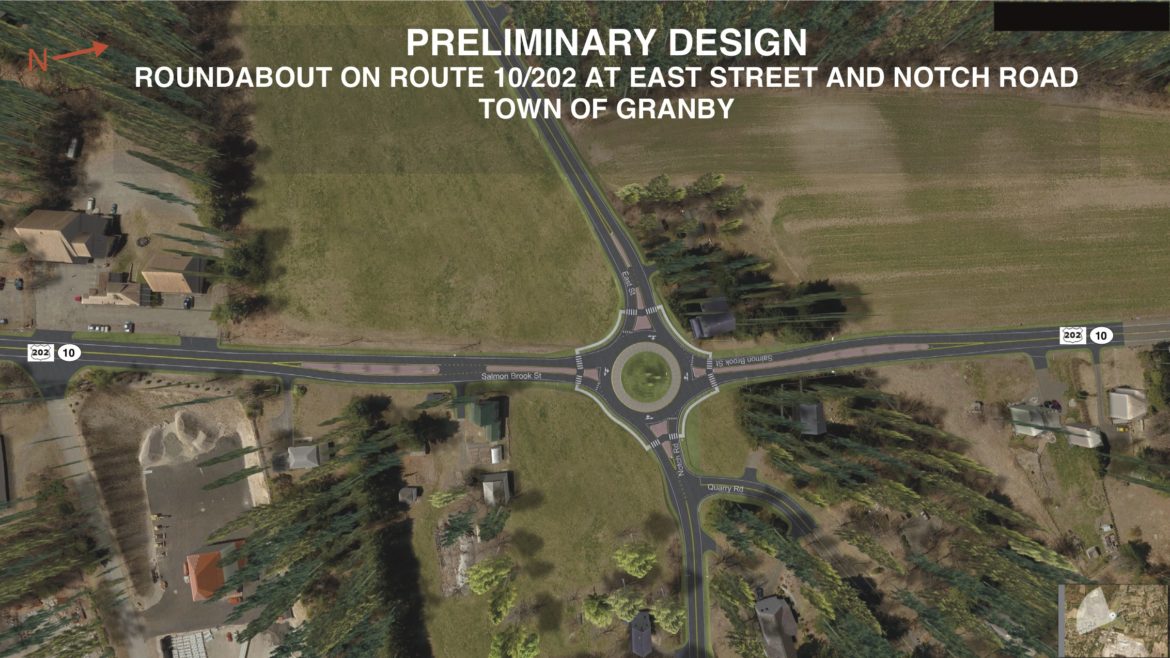A full house greeted members of the State Department of Transportation on Sept. 26 in the Senior Center to hear the latest on the proposed roundabout at the intersection of Rte. 10/202 with East Street and Notch Road. At the time of this meeting, approximately 30 percent of the design of the project had been completed. Very clear photographs with the design overlayed were shown on the screen and in handouts.
Back in 1995, the town asked the state for a traffic light for this intersection, but study showed that there was not enough volume to warrant installing one, according to a federal manual of traffic control devices that the state uses for guidance. In 2010, Notch and Quarry were re-configured and the town once again requested a traffic light, but again the state study indicated that there was not enough volume to justify it. Because of continued safety concerns, in 2016 the state offered the roundabout solution, which will also eliminate the vertical sight line problem when a driver from Notch Road or East Street attempts to enter Rte. 10/202 while looking back toward Granby center.
The presenters reported that from 2013 to 2017, there were 27 crashes at this site. Most of these were “angle crashes,” and 14 of them led to serious injuries.
Roundabouts are similar to traffic circles, but roundabouts are smaller and tighter, which keeps speed down, and drivers yield to traffic coming only from their left. There is no weaving or lane-changing as in traffic circles. Connecticut lags behind all the other New England states except Rhode Island in numbers of roundabouts, with Maine leading the way at 22 and Massachusetts at 20. Connecticut has six at this time.
As opposed to traffic lights, roundabouts do not lead to long lines of cars waiting for the light to turn. The lack of idling saves time, gas and reduces pollution. The DOT speakers noted that traffic lights actually result in more rear-end crashes and other crashes caused by drivers trying to “beat the light.” There is also a high number of head-on and turning crashes. In a roundabout, speed is reduced to 15-25 mph but traffic keeps moving and all turns are right-hand, eliminating multiple decision-making instances.
The roundabout is designed with aesthetics and safety in mind. It will consist of a central landscaped island and splitter islands in each of the approaching roads. The landscaping in the splitters helps to “channelize” the approaching drivers. Lighting will be consistent with that already installed in Granby. There will be sidewalks for pedestrians and bicyclists, and an apron around the central island to accommodate large trucks or cars with trailers. For safety purposes, the roundabout is constructed tightly, presenting a problem for oversized loads coming through town. The drivers of such loads must apply for a permit to pass through a town, at which time the drivers will be directed to an alternate route so as to avoid difficulty in the roundabout.
The cost of the project is estimated at $4,100,000 of which 80 percent is covered by the federal government and the remaining 20 percent by the State of Connecticut. The money is budgeted for 2020, the year in which the project is scheduled to begin. Construction will take place during off-peak traffic hours, at times utilizing alternating one-way passage.
The project necessitates acquiring property from those owners at the intersection. The procedure begins with the owners receiving a letter of intent, followed by valuation of the property to be acquired. Then, during a private meeting with the property owner, an offer of just compensation will be made; negotiation may ensue. The owner has six months to appeal, after which, if there is an impasse, according to state and federal statutes, the land may be taken by eminent domain. The amount of land expected to be acquired for the rights of way from each owner is quite small — described as “partial slivers” and easements.
The presentation was followed by a question and answer period during which several residents expressed concerns about various aspects of the project. Many were of the opinion that this project is not needed.
One resident had accessed the state data for accidents at the intersection since the re-alignment of the roads in 2010, saying that 15 crashes had taken place during that time, seven of which had resulted in minor injuries. This does not match the higher numbers and more serious instances reported by the presenters. Some residents felt that lack of attention (cell phone use) was as much to blame as anything else for these accidents and that this will continue to occur whether a roundabout or straight road.
It was questioned why a four-way stop-sign installation wouldn’t be just as effective and far less expensive. The answer continued to be the safety factor of the roundabout.
Some residents also questioned the state spending the large amount of money when it is having such severe budget issues. The answer was that the money is already budgeted, as stated above.
Residents were encouraged to submit comments on the handouts available. It was requested that these comments be sent in the next two weeks. There was no timetable given for when the town would receive information on the results of the input.
